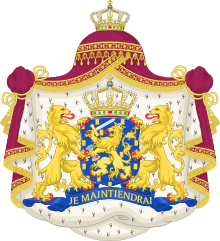| Coat of arms of the Kingdom of the Netherlands | |
|---|---|
 Greater (royal) version | |
| Versions | |
 Middle (state) version | |
 Lesser version | |
| Armiger | Willem-Alexander of the Netherlands |
| Adopted | 10 July 1907 23 April 1980[1] |
| Crest | Dutch royal Crown |
| Shield | Azure, billetty Or a lion with a coronet Or armed and langued Gules holding in his dexter paw a sword Argent hilted Or and in the sinister paw seven arrows Argent pointed and bound together Or |
| Supporters | Two lions rampant Or armed and langued Gules |
| Motto | French: Je Maintiendrai |
| Other elements | The monarch places this coat of arms on a mantle gules lined with Ermine. Above the mantle is a pavilion gules again topped with the royal crown. |
| Earlier version(s) | 24 August 1815 |
The coat of arms of the Kingdom of the Netherlands was originally adopted in 1815 and later modified in 1907. The arms are a composite of the arms of the former Dutch Republic and the arms of the House of Nassau, it features a checkered shield with a lion grasping a sword in one hand and a bundle of arrows in the other and is the heraldic symbol of the monarch (King Willem-Alexander) and the country. The monarch uses a version of the arms with a mantle (Dutch: Koninklijk wapen) while the government of the Netherlands uses a smaller version without the mantle (cloak) or the pavilion, sometimes only the shield and crown are used (Dutch: Rijkswapen). The components of the coats of arms were regulated by Queen Wilhelmina in a royal decree of 10 July 1907, affirmed by Queen Juliana in a royal decree of 23 April 1980.[1]
- ^ a b Besluit tot het voeren van het Koninklijk wapen (1908) Archived 2017-12-21 at the Wayback Machine wetten.nl